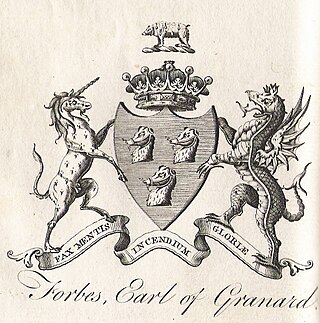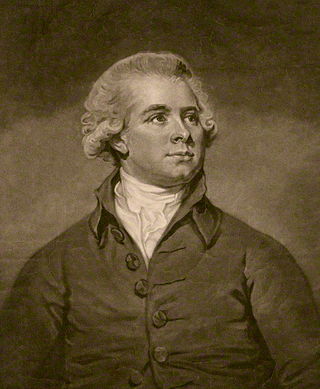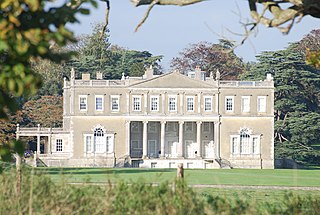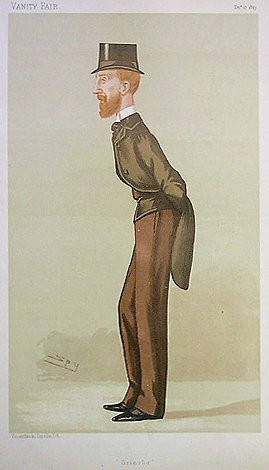
Earl of Lindsey is a title in the Peerage of England. It was created in 1626 for the 14th Baron Willoughby de Eresby. He was First Lord of the Admiralty from 1635 to 1636 and also established his claim in right of his mother to the hereditary office of Lord Great Chamberlain of England. Lord Lindsey fought on the Royalist side in the Civil War and was mortally wounded at the Battle of Edgehill on 23 October 1642. He was succeeded by his son, the second earl. He also fought at Edgehill and surrendered to the Parliamentarians in order to attend his mortally wounded father. Lord Lindsey later fought at the First Battle of Newbury, Second Battle of Newbury, and at Naseby. His son from his second marriage, James, was created Earl of Abingdon in 1682. He was succeeded by his son from his first marriage to Martha Cockayne, the third Earl. He represented Boston in the House of Commons and served as Lord Lieutenant of Lincolnshire.

Earl of Dartmouth is a title in the Peerage of Great Britain. It was created in 1711 for William Legge, 2nd Baron Dartmouth.

Earl of Aylesford, in the County of Kent, is a title in the Peerage of Great Britain. It was created in 1714 for the lawyer and politician Heneage Finch, 1st Baron Guernsey. He had already been created Baron Guernsey in the Peerage of England in 1703. Finch was the younger son of Heneage Finch, 1st Earl of Nottingham and the great-grandson of Elizabeth Heneage, 1st Countess of Winchilsea. Lord Aylesford's eldest son, the second Earl, represented Maidstone and Surrey in Parliament. In 1712, he married Mary Fisher, daughter of Sir Clement Fisher, 3rd Baronet. Through this marriage Packington Hall in Warwickshire came into the Finch family. Their son, the third Earl, sat as a Member of Parliament for Leicestershire and Maidstone. His eldest son, the fourth Earl, represented Castle Rising and Maidstone in the House of Commons, and after entering the House of Lords on his father's death, served as Captain of the Yeomen of the Guard from 1783 to 1804 and as Lord Steward of the Household from 1804 to 1812.

Earl of Granard is a title in the Peerage of Ireland. It was created in 1684 for Arthur Forbes, 1st Viscount Granard. He was a lieutenant-general in the army and served as Marshal of the Army in Ireland after the Restoration and was later Lord Justice of Ireland. He had already succeeded his father as second Baronet of Castle Forbes and been created Baron Clanehugh and Viscount Granard in 1675, also in the Peerage of Ireland. The baronetcy, of Castle Forbes in county Longford, was created in the Baronetage of Nova Scotia on 29 September 1628 for his father, Arthur Forbes.

Earl of Kingston is a title in the Peerage of Ireland. It was created in 1768 for Edward King, 1st Viscount Kingston. The Earl holds the subsidiary titles Baron Kingston, of Rockingham in the County of Roscommon, Viscount Kingston, of Kingsborough in the County of Sligo, Baron Erris, of Boyle in the County of Roscommon, and Viscount Lorton, of Boyle in the County of Roscommon, also in the Peerage of Ireland. He is also a baronet in the Baronetage of Ireland. Between 1821 and 1869 the earls also held the title Baron Kingston, of Mitchelstown in the County of Cork, in the Peerage of the United Kingdom.

Baron Bagot, of Bagot's Bromley in the County of Stafford, is a title in the Peerage of Great Britain. It was created on 12 October 1780 for Sir William Bagot, 6th Baronet.
Baron Kensington is a title that has been created three times, in the Peerages of England, Ireland and the United Kingdom.

Baron Henniker, of Stratford-upon-Slaney in the County of Wicklow, is a title in the Peerage of Ireland. It was created in 1800 for Sir John Henniker, 2nd Baronet, who had previously represented Sudbury and Dover in the House of Commons. His son, the second Baron, also sat as a Member of Parliament. In 1792 he assumed by Royal licence the additional surname of Major. He was childless and was succeeded by his nephew, the third Baron. He assumed the additional surname of Major by Royal licence in 1822. His son, the fourth Baron, represented Suffolk East in Parliament. In 1866 he was created Baron Hartismere, of Hartismere in the County of Suffolk, in the Peerage of the United Kingdom. This title gave him and his descendants an automatic seat in the House of Lords. He was succeeded by his son, the fifth Baron. He also sat as Member of Parliament for Suffolk East and later held minor office in the Conservative administrations of Benjamin Disraeli and Lord Salisbury. His grandson, the eighth Baron, was a prominent diplomat and notably served as British Ambassador to Jordan and to Denmark. As of 2014 the titles are held by the latter's son, the ninth Baron, who succeeded in 2004.

Baron Hotham, of South Dalton in the County of York, is a title in the Peerage of Ireland. It was created in 1797 for the naval commander Admiral William Hotham, with remainder to the heirs male of his father. Hotham was the third son of Sir Beaumont Hotham, 7th Baronet, of Scorborough, and in 1811 he also succeeded his nephew as eleventh Baronet. Lord Hotham never married and on his death in 1813 he was succeeded in both titles by his younger brother Beaumont, the second Baron and twelfth Baronet. He had previously represented Wigan in the House of Commons.

Baron Henley is a title that has been created twice: first in the Peerage of Great Britain and then in the Peerage of Ireland. The first creation came in 1760 in favour of Sir Robert Henley, Lord High Chancellor of Great Britain, when he was created Lord Henley, Baron of Grainge, in the County of Southampton. In 1764 he was further honoured when he was made Earl of Northington. On the death of his son, the second Earl, both titles became extinct. Lady Elizabeth Henley, youngest daughter of the first Earl and co-heiress of the second Earl, married the diplomat Morton Eden. In 1799, the Henley title was revived when Eden was created Baron Henley, of Chardstock in the County of Dorset, in the Peerage of Ireland. Their son, the second Baron, assumed the surname of Henley in lieu of Eden and notably published a biography of his maternal grandfather. His son, the third Baron, sat as Liberal Member of Parliament for Northampton. In 1885 the Northington title was also revived when he was created Baron Northington, of Watford in the County of Northampton, in the Peerage of the United Kingdom. This title gave the Barons an automatic seat in the House of Lords. The fourth baron Frederick Henley was an educated man who served as JP in Northamptonshire and married Augusta, daughter of Herbert Langham 12th baronet.
Baron Hamilton of Dalzell, in the County of Lanark, is a title in the Peerage of the United Kingdom. It was created in 1886 for the Liberal politician John Hamilton. He had previously represented Falkirk and Lanarkshire South in the House of Commons and after his elevation to the peerage served under William Ewart Gladstone as a Government Whip from 1892 to 1894. His eldest son, the second Baron, was a Government Whip from 1905 to 1911 in the Liberal administrations of Henry Campbell-Bannerman and H. H. Asquith and also served as Lord Lieutenant of Lanarkshire. His nephew, the third Baron, was Lord Lieutenant of Surrey. As of 2010 the title is held by the latter's grandson, the fifth Baron, who succeeded his father in 2006.

Baron Ashcombe, of Dorking in the County of Surrey and of Bodiam Castle in the County of Sussex, is a title in the Peerage of the United Kingdom. It was created in 1892 for the Conservative politician George Cubitt of Denbies House, Dorking, Surrey, who was continuously elected at elections over a 32-year period. He was the son of the architect Thomas Cubitt. Lord Ashcombe was succeeded by his son, the second Baron. He was a Conservative Member of Parliament and also served as Lord Lieutenant of Surrey. As of 2013, the title is held by his kinsman, the fifth Baron, who succeeded his first cousin, once removed in 2013.
Baron Skelmersdale, of Skelmersdale in the County Palatine of Lancaster, is a title in the Peerage of the United Kingdom. It was created in 1828 for the former Member of Parliament for Westbury, Newcastle-under-Lyme, Clitheroe and Dover, Edward Bootle-Wilbraham. His grandson, the second Baron, was a Conservative politician and served in the Conservative administrations of Disraeli and Lord Salisbury. In 1880 he was created Earl of Lathom, in the County Palatine of Lancaster, in the Peerage of the United Kingdom. However, the earldom became extinct on the death of his grandson, the third Earl, in 1930. The barony passed to the last Earl's second cousin once removed, the fifth Baron, who was the grandson of a younger son of the first Baron. On his death, the title was inherited by his cousin, the sixth Baron.
Baron Congleton, of Congleton in the County Palatine of Chester, is a title in the Peerage of the United Kingdom. It was created in 1841 for the Whig politician and former Secretary at War and Paymaster of the Forces Sir Henry Parnell, 4th Baronet. His eldest son, the second Baron, devoted his life to religious work and was an early member of the Plymouth Brethren. The latter was succeeded by his younger brother, the third Baron. He served in the Royal Navy and fought at the Battle of Navarino in 1827. His eldest surviving son, the fourth Baron, was a major-general in the British Army and served in the Crimean War and in the Anglo-Zulu War. The latter's eldest son, the fifth Baron, was killed in action in Ypres Salient during the First World War and was succeeded by his younger brother, the sixth Baron. As of 2015, the titles are held by the latter's grandson, the ninth Baron, who succeeded his father in 2015.
Baron Aldenham, of Aldenham in the county of Hertfordshire, is a title in the Peerage of the United Kingdom that was created on 31 January 1896 for the businessman Hucks Gibbs. He was head of the family firm of Antony Gibbs & Sons and a director and Governor of the Bank of England. Gibbs also briefly sat as a Conservative Member of Parliament for the City of London. His fourth son Herbert Cokayne Gibbs was created Baron Hunsdon of Hunsdon in 1923.

Baron Alington was a title that was created three times in British history. The first creation came in the Peerage of Ireland on 28 July 1642 when William Alington was made Baron Alington, of Killard in the County of Cork. His second son, the third Baron, was a Major-General in the English Army. On 5 December 1682 he was created Baron Alington, of Wymondley in the County of Hertford, in the Peerage of England. The English barony became extinct on the death of his young son Giles, the fourth Baron, in 1691. The late Baron was succeeded in the Irish barony by his uncle, the fifth Baron. He was a captain in the army. On his death, in February 1723, the Irish barony became extinct as well.

Baron Dorchester was a title that was created twice in British history, once in the Peerage of Great Britain and once in the Peerage of the United Kingdom. The first creation came in the Peerage of Great Britain on 21 August 1786 when the soldier and administrator Sir Guy Carleton was made Lord Dorchester, Baron of Dorchester, in the County of Oxford. He was succeeded by his grandson, the second Baron. He was the only son of the Hon. Christopher Carleton, third son of the first Baron. The second Baron died unmarried at an early age and was succeeded by his first cousin, the third Baron. He was the only son of the Hon. George Carleton, fourth son of the first Baron. He had no sons and was succeeded by his first cousin, the fourth Baron. He was the only son of the Reverend and Hon. Richard Carleton, seventh son of the first Baron. The fourth Baron was a Colonel in the Coldstream Guards. He was childless, and the title became extinct upon his death on 30 November 1897.

Edward Heneage, 1st Baron Heneage, was a British Liberal and Liberal Unionist politician. He was briefly Chancellor of the Duchy of Lancaster under William Ewart Gladstone between February and April 1886, when he broke with Gladstone over Irish Home Rule and joined the Liberal Unionists.
George Fieschi Heneage was a British Whig politician.
Baron Dunleath, of Ballywalter in the County of Down, is a title in the Peerage of the United Kingdom. It was created on 29 August 1892 for the businessman and former Conservative Member of Parliament for Downpatrick, John Mulholland. The Mulholland family were involved in the cotton and linen industry in Ulster in the north of Ireland. The first Baron's son, the second Baron, represented Londonderry North in the House of Commons as a Conservative. His grandson, the fourth Baron, was a member of the Northern Ireland Assembly for the Alliance Party. He was succeeded by his first cousin, the fifth Baron, who had already succeeded his father as second Baronet of Ballyscullion. As of 2017 the titles are held by the fifth Baron's son, the sixth Baron, who succeeded in 1997.








